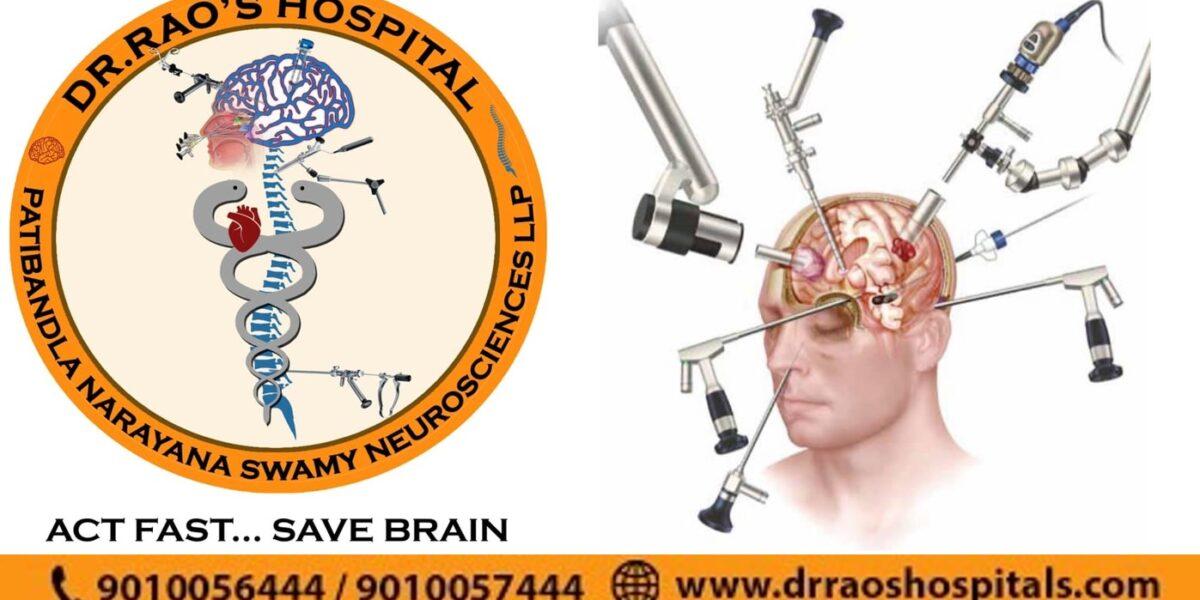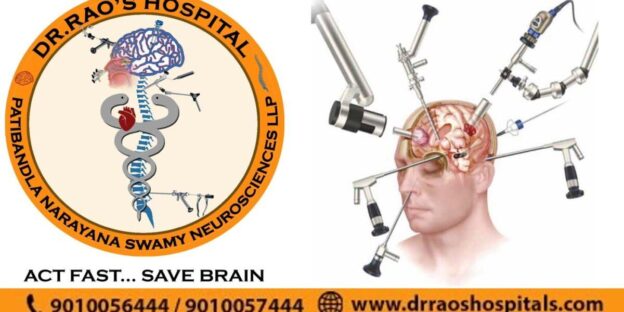Dr. Rao’s Hospital: Pioneering Excellence in Neurosurgery and Spine Surgery for International Patients
Introduction
Minimally invasive neurosurgery (MIS) is a type of surgery that uses small incisions and specialized instruments to access the brain and spine. MIS procedures are typically performed using an endoscope, which is a long, thin tube with a light and camera attached to its end. This allows the surgeon to see inside the body without making a large incision. MIS procedures have many potential benefits over traditional open surgery, including less blood loss, shorter hospital stays, and quicker recovery times. In addition, MIS procedures are often less invasive and cause less damage to surrounding tissue. As a result, patients who undergo minimally invasive neurosurgery often experience fewer complications and a lower risk of infection. Despite these potential benefits, minimally invasive neurosurgery is not appropriate for all patients or all conditions. In some cases, open surgery may be the best option. Your surgeon will discuss all of your treatment options with you and help you decide if minimally invasive neurosurgery is right for you. According to mid-day
At Dr. Rao’s Hospital, one of the best neurology hospitals in Guntur, the endoscopic neurosurgery unit is equipped with state-of-the-art medical infrastructure and cutting-edge technology. Our medical head, Dr. Mohana Rao Patibandla, one of the best neurosurgeons in Guntur, holds years of experience in performing endoscopic neurosurgery in Guntur and had training from the USA. Dr. Rao’s hospital is known for the keyhole brain and spine surgeries.
Moreover, the hospital comprises a team of the best neurosurgeons and the best neurologists in Guntur. They are skilled in various advanced techniques for treating complex problems such as brain aneurysms, and spine and brain tumors that are difficult to reach with greater precision.
Conditions Treated Using minimally invasive neurosurgery Procedures
Minimally invasive neurosurgery can be used to treat a number of conditions affecting the brain and spine. These include:
Brain tumors
Meningiomas
Pituitary tumors
Trigeminal neuralgia
Arteriovenous malformations (AVMs)
Craniosynostosis
Epidermoid cysts
Hemangiomas
Hydrocephalus
Intracranial aneurysms
Spine conditions
- Degenerative disc disease
- Herniated disc
- Lumbar spinal stenosis
- Spinal deformities such as scoliosis
- Spinal infections
- Spinal instability including spondylolisthesis
- Vertebral compression fractures
- Spinal tumors
How Minimally Invasive Surgery Works
Minimally invasive neurosurgery (MIS) is a type of surgery that uses smaller incisions and less tissue disruption than traditional open surgery. MIS techniques can be used to treat a variety of conditions affecting the brain and spine. MIS procedures are typically performed using an endoscope, which is a long, thin tube equipped with a light and camera. The endoscope is inserted through a small incision in the skull or spine, and the surgeon uses the camera to guide the endoscope to the site of the surgery. However, percutaneous (meaning “through the skin”) placement typically involves inserting rods and screws through relatively small skin incisions without cutting or dissecting the underlying muscle. With the aid of x-ray images, guidewires are placed through the skin and into the spinal vertebrae along the desired paths for the screws. Then, screws are placed over the guidewires and follow the path of the wires. These screws have temporary extenders that extend outside of the skin and are subsequently removed after helping to guide passage of rods to connect and secure the screws. With the use of spinal navigation and robots, spinal instrumentation is being placed more safely and accurately.
During MIS surgery, the surgeon will make small incisions in the skin and muscle tissue to access the bones of the skull or spine. Once the endoscope is in place, the surgeon will use special instruments to remove or repair damaged tissue. MIS surgery is less invasive than traditional open surgery, and as a result, patients typically experience less pain and scarring. In addition, MIS surgery can often be performed on an outpatient basis, which means that patients can go home the same day as their procedure.
Common minimally invasive neurosurgery Surgery Treatment Options
There are many different types of minimally invasive neurosurgery procedures, each of which is designed to treat a specific condition. Some of the most common minimally invasive neurosurgery procedures include:
• Spinal cord stimulation: This procedure involves implanting a small device near the spinal cord that sends electrical impulses to the nerves in order to relieve pain.
• Deep brain stimulation: This procedure involves implanting a small device in the brain that sends electrical impulses to specific areas in order to relieve symptoms of conditions like Parkinson’s disease or dystonia.
• Intrathecal drug delivery: This procedure involves implantation of a small pump in the lower back that delivers medication directly to the spinal fluid. This is often used to treat pain or spasticity that is not responding to other forms of treatment.
• Peripheral nerve stimulation: This procedure involves implanting a small device near a peripheral nerve that sends electrical impulses to the nerve in order to relieve pain.
A number of specific techniques have been deployed for MIS surgery. Though the field continues to develop, the list below highlights some of the most common options.
Discectomy: Spinal discs are essentially elastic rings with soft material inside that serve as cushions between the vertebral bones. If the elastic ring becomes weakened, the soft tissue inside can extrude — or herniate — outside of the elastic ring. The herniated disc material can compress the nerves passing by, thus causing pain. If surgical treatment is recommended to trim or remove the herniated disc, it may be possible to perform this procedure with MIS surgery using tubular dilators and a microscope or endoscope.
Spinal decompression:Spinal stenosis, which is a narrowing of the vertebral canal, is a common condition that can result in compression of the nerves. This can produce a variety of symptoms, including pain, numbness and muscle weakness. If surgery is recommended, it may be possible to remove the bone and soft tissues causing the nerve compression through an MIS approach using tubular dilators and a microscope or endoscope. The more common decompressive procedures include laminectomy and foraminotomy.
Transforaminal Lumbar Interbody Fusion (TLIF): This is a MIS technique that is performed for patients with refractory mechanical low back and radicular pain associated with spondylolisthesis, degenerative disc disease and recurrent disc herniation. The procedure is performed from the back (posterior) with the patient on his or her stomach. Utilizing two small incisions, screws and rods are placed between two or more vertebral levels. The intervertebral disc is removed and a cage filled with bone is placed in that void with the goal of stabilizing the levels affected.
- Minimally Invasive Lateral Interbody Fusion
- Minimally Invasive Posterior Lumbar Interbody Fusion (PLIF)
- Minimally Invasive Transforaminal Lumbar Interbody Fusion (TLIF)
- Minimally Invasive Posterior Thoracic Fusion
Candidates for minimally invasive neurosurgery Surgery
Candidates for minimally invasive neurosurgery surgery are typically those who have conditions that require surgery but are not well suited for traditional, open surgery. These conditions can include tumors, aneurysms, and other conditions that require access to the brain or spine. In order to be a candidate for minimally invasive neurosurgery, you must first be evaluated by a neurosurgeon. During this evaluation, the neurosurgeon will determine if your condition is appropriate for this type of surgery. They will also take into account your overall health and any other factors that may impact your ability to tolerate the surgery.
minimally invasive neurosurgery Device Technology
One of the most important aspects of minimally invasive neurosurgery is the technology used to perform the procedures. This technology has evolved significantly over the past few years and has made these procedures much safer and more effective. Some of the most common devices used in minimally invasive neurosurgery include:
Microscopes: These are used to provide the surgeon with a magnified view of the area being operated on.
Endoscopes: These are long, thin tubes that are inserted into the body to allow the surgeon to see inside without making a large incision.
Lasers: Lasers are often used to remove tissue or to cauterize blood vessels.
Ultrasonic devices: These devices use sound waves to break up tissue so it can be removed more easily.
Conclusion
Minimally invasive neurosurgery is a type of surgery that uses small incisions and specialized instruments to treat conditions of the brain and spine. This type of surgery can be used to treat a variety of conditions, including tumors, herniated discs, and spinal stenosis. Minimally invasive neurosurgery is often used as an alternative to traditional open surgery, which can require large incisions and a longer recovery period. Candidates for minimally invasive neurosurgery include those who are seeking an alternative to traditional open surgery, have a condition that can be treated using minimally invasive techniques, and are in generally good health. The decision to undergo minimally invasive neurosurgery should be made in consultation with a qualified surgeon. Minimally invasive neurosurgery is a safe and effective treatment option for many conditions of the brain and spine. This type of surgery can offer patients a number of benefits, including a shorter recovery period, less pain, and a lower risk of complications. Taking every point into consideration, Dr. Rao is the best minimally invasive brain or spine surgeon in India as he has abroad experience, is a minimally invasive surgeon, fewer complication rate, compassionate to the patient, has the highest google rating for any neurosurgeon has in India, and is Best cutting edge technology at his Dr. Raos hospital/patibandla Narayana Swamy Neurosciences institute.


